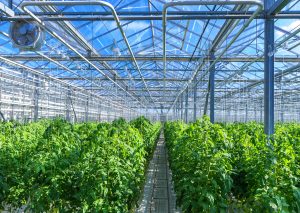Extreme weather, believed to result from climate change and increased atmospheric CO2 levels, is a concern for many. And beyond extreme events, global warming is also expected to impact agriculture.1,2
Although it is expected that climate change will significantly affect agriculture and cause decreases in crop yields, the full effects of climate change on agriculture and human food supplies are not yet understood.2,3,4
Simulating a Changing Climate
To fully understand the effects that changes in temperature, CO2, and water availability caused by climate change may have on crop growth and food availability, scientists often employ controlled growth chambers to grow plants in conditions that simulate the expected atmospheric conditions at the end of the century. Growth chambers enable precise control of CO2 levels, temperature, water availability, humidity, soil quality and light quality, enabling researchers to study how plant growth changes in elevated CO2 levels, elevated temperatures, and altered water availability.
However, plant behavior in the field often differs significantly from in growth chambers. Due to differences in light quality, light intensity, temperature fluctuations, evaporative demand, and other biotic and abiotic stress factors, the growth of plants in small, controlled growth chambers doesn’t always adequately reflect plant growth in the field and the less realistic the experimental conditions used during climate change simulation experiments, the less likely the resultant predictions will reflect reality.4
Over the past 30 years, there have been several attempts to more closely simulate climate change growing scenarios including open top chambers, free air CO2 enrichment, temperature gradient tunnels and free air temperature increases, though each of these methods has significant drawbacks.
For example, chamber-less CO2 exposure systems do not allow rigorous control of gas concentrations, while other systems suffer from “chamber effects” included changes in wind velocity, humidity, temperature, light quality and soil quality.4,5
Recently, researchers in Spain have reported growth chamber greenhouses and temperature gradient greenhouses, designed to remove some of the disadvantages of simulating the effects of climate change on crop growth in growth chambers. A paper reporting their methodology was published in Plant Science in 2014 and describes how they used growth chamber greenhouses and temperature gradient greenhouses to simulate climate change scenarios and investigate plant responses.4
Choosing the Right Growth Chamber
Growth chamber and temperature gradient greenhouses offer increased working area compared with traditional growth chambers, enabling them to work as greenhouses without the need for isolation panels, while still enabling precise control of CO2 concentration, temperature, water availability, and other environmental factors.
Such greenhouses have been used to study the potential effects of climate change on the growth of lettuce, alfalfa, and grapevine.
CO2 Sensors for Climate Change Research
For researchers to study the effects of climate change on plant growth using growth chambers or greenhouses, highly accurate CO2 measurements are required.
The Spanish team used the Edinburgh Sensors Guardian sensor in their greenhouses to provide precise, reliable CO2 measurements. Edinburg Sensors is a customer-focused provider of high-quality gas sensing solutions that have been providing gas sensors to the research community since the 1980s.4,6
The Guardian NG from Edinburgh Sensors provides accurate CO2 measurements in research greenhouses mimicking climate change scenarios. The Edinburgh Sensors Guardian NG provides near-analyzer quality continuous measurement of CO2 concentrations. The CO2 detection range is 0-3000 ppm, and the sensor can operate in 0-95% relative humidity and temperatures of 0-45 °C, making it ideal for use in greenhouses with conditions intended to mimic climate change scenarios.
Furthermore, the Guardian NG is easy to install as a stand-alone product in greenhouses to measure CO2, or in combination with CO2 controllers as done by the Spanish team in their growth control and temperature gradient greenhouses.4,6 Conclusions Simulating climate change scenarios in with elevated CO2 concentrations is essential for understanding the potential effects of climate change on plant growth and crop yields. Accurate CO2 concentration measurements are essential for such studies, and the Edinburgh Sensors Guardian NG is an excellent option for researchers building research greenhouses for climate change simulation.
References
- http://www.charlotteobserver.com/news/nation-world/article171632462.html Accessed September 7th, 2017.
- Walthall CL, Hatfield J, Backlund P, et al. ‘Climate Change and Agriculture in the United States: Effects and Adaptation.’ USDA Technical Bulletin 1935, 2012. Available from: http://lib.dr.iastate.edu/cgi/viewcontent.cgi?article=1000&context=ge_at_reports
- https://www.co2.earth/2100-projections Accessed September 7th, 2017.
- Morales F, Pascual I, Sánchez-Díaz M, Aguirreolea J, Irigoyen JJ, Goicoechea N Antolín MC, Oyarzun M, Urdiain A, ‘Methodological advances: Using greenhouses to simulate climate change scenarios’ Plant Science 226:30-40, 2014.
- Aguirreolea J, Irigoyen JJ, Perez P, Martinez-Carrasco R, Sánchez-Díaz M, ‘The use of temperature gradient tunnels for studying the combined effect of CO2, temperature and water availability in N2 fixing alfalfa plants’ Annals of Applied Biology, 146:51-60, 2005.
- https://edinburghsensors.com/products/gas-monitors/guardian-ng/ Accessed September 7th, 2017.

